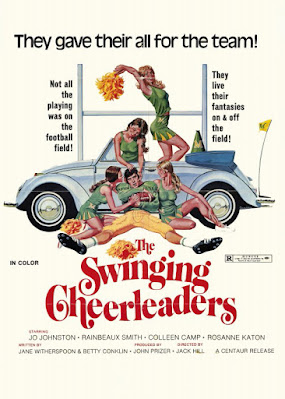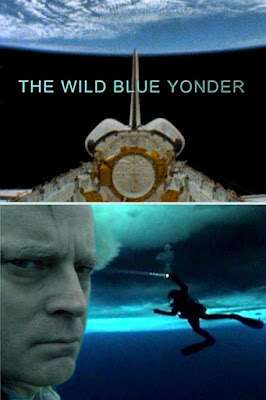Director: Chester Novell Turner
Screenplay: Chester Novell Turner
Cast: Shirley L. Jones as Helen Black; Ricky Roach
as the First Lover; Chester Tankersley as the Second Lover; Marie Sainvilvs as
the Saleslady; Jeanine Johican as the Church Friend
An Abstract List
Candidate/A Night of a Thousand Horror (Movies) #164
You're going to burst Hell wide open...!
Black Devil Doll from Hell is one of only two tales from Chester Novell Turner, an independent African American director who made two idiosyncratic shot-on-video tales, only to vanish until when he was relocated as part of those two films being rediscovered. One is Tales from the Quadread Zone (1987), a horror anthology. The other is Black Devil Doll from Hell, the most famous of the duo and originally meant to be a segment of the other before being expanded into a full length tale. The production was re-edited by David Ichikawa; whilst the song he added for the opening credits is a delight, a slightly disconnected rock track being your nightmare by him, I am aware that, when Turner had this film distributed by Hollywood Home Theater, “they just screwed me six ways to Sunday.“1 In fact, this was the catalyst for Turner to sell Tales from the Quadread Zone independently, making it one of the rarest videotapes in existence in the United States large sums of money were paid for, and the factor in him vanishing from his filmmaking career at the time due the lack of success financially distributing Quadread Zone independently.
The film itself is...well, is a lot more complicated and uncomfortable than its notoriety as a SOV evil doll oddity may suggest. It begins at an actual church, Turner's own score prepare for the usually oddball tone of a SOV film from the era, but you are not prepared for what is him trying at a metaphor with psychological complexity, a morality tale that came from his own love for the likes of The Twilight Zone. Shirley L. Jones plays Helen, a very devout Christian woman who goes to church, a person who openly scolds a man who looks at first hand like a flasher or trying to pick up women, only to be found to be selling stolen objects on like coats. She also manages to find Satan's doll helper in a second hand store.
The doll is naturally alive, but where the film gets uncomfortable but fascinating, as well as truly weird, is how the doll becomes effectively a personification of toxic masculinity and links to Helen's sexual desires. Effectively this, due to the SOV quality and Turner working with his home environment, shooting in Chicago, is the ordinary life of a single African American woman, struggling with her own sexuality against her religious beliefs, if invaded by a demon puppet film which adds a strange additional metaphor. Turner himself argues that the doll was like a Monkey's Paw, that "He can give you whatever that’s in your heart."1, which does raise some troubling aspects to how the plot plays on but in itself is fascinating in how it is executed. Suppressed and clashing with her own faith, the doll when it comes alive, a creepy figure times even played by Turner's nephew in some shots, grants a wish for Helen when she originally wanted to abstain until marriage. In her case, trigger warning, Turner either unintentionally leaned on problematic content or on themes of concern as her fantasy starts off as sexual violence with a violently aggressive male figure, a personification of violent masculinity who uses derogatory speech and aggression, as part of said desires.
This also means, again with the trigger warning, a sex scene which, even if it involves him using his horrible breath on her, starts off as a rape scene. Even without this factor, it comes off as a BDSM light fantasy with a puppet, involving uncomfortable role play for a viewer. It is morally complicated to watch, with the sense of whether Turner realised the tone or not for the scene even if he had deliberately wanted to make a viewer uncomfortable. It is also one of the strangest scenes I have ever witnesses as, yes, you have the main actress Shirley L. Jones and a prop puppet (which she helped in production of) acting out a sex scene. Jones bravely stars in the film, as the person I admire the most, willingly in this film doing a lot of nudity and this aforementioned sex scene, including an initial shower scene where she suddenly starts to have sexual fantasies kindled. Not a professional actress, she only has worked on these two Turner films, with the added weight that she feels like a regular woman cast onscreen for an added sense of realism, not a professional actor whose appearance and acting style is manufactured by external sources. She and Turner also developed a romance during the production of the film, which does sooth some of the content at least in knowledge that, alongside being game to star in the film, Jones actually felt comfortable acting this material out.
Is the scene, what the film is getting at, defendable? It is problematic, and there is literally a scene where the phrase "raped by a puppet" gets brought up over and over again further on, but I wonder if Turner, in his logic, was trying at a greater meaning. I cannot help, as the doll is a vile creature who uses "bitch" frequently and dominates, that he is a personification of the worst in men, unfortunately someone whose charisma attracts Helen, the Monkey's Paw effect here unfortunately for her offering her desires in a form where she is made submissive.
When she renounces her faith and decides to embrace her sexual desire, it is only to find that for her, the puppet was a better love for her than an actual man, which adds to this perverse tale as she goes for the perfect (human) lover only to be trapped with no actual man of flesh being good enough to satisfy her like the doll did. You can even add a gigolo metaphor, even if unintentional, as the puppet returns to the store and needs to be bought by women over and over. It is all problematic, but Helen is never a demonised character even when she fully renounces her faith, throwing the Bible and household objects in the bin, which adds to the complexity. The moral tale is that, sadly, even acquiring the doll and letting it tempt her into the trap. Gender politics issues aside, and in mind that the film's logic is weird, it could have much worse in how this was presented.
As a moral tale, where unsatisfied she attempts to reacquire the doll only for his to be her downfall, but she was never someone doomed by her weakness, whether deliberate or a flaw in Turner as a storyteller. It instead feels like a bleak tale inexplicably appearing to us in this perplexing madness, of a woman tragically caught up in an abusive sexual encounter and without any one to help her recover. It is not pleasant, considering this film is seen as a bizarre cult film held aloft as psychotronic cinema, with no warning of this when I first of this, but that is the fault of writers who did not mention the film's secret bleakness, as with the jarring tonal shifts in Tales from the Quadred Zone. Both suggest some deliberateness to Turner's style, even if it did not completely work, as he was not shying away from the darker sides of life between this and that later film ending on a character committing suicide.
As with so much of this type of cinema, it feels like a home movie but this has become for me of great merit, as arguably once you adapt to their logic they make worthy time capsules of what locations and time periods were like over slickly produced films. This may sound crass or heavy handed, so I am careful with my words, but with representations of African Americans in American horror cinema still a minority, this film stands out especially as Chester Novell Turner is a rarity from the SOV era when it was almost entirely white men making them. Black Devil Doll from Hell is not a film I want to chuck away glibly for a lot of reasons, and this is a factor also the consider, where the church filmed in at the start is an all-black church, with a preacher being recorded saying his sermon, and the homes are ordinary places as in micro budget cinema with people's real bric-a-brac decorating the environments.
The look of this film, even without this in mind, is so stark it adds to the perversity. (On a lighter note for this review, once I got used to the Casio music, the music by Turner himself eventually become so percussive for me I was actually getting caught up into it) Baring in mind, even if he bungled the presentation and made a much more difficult film to accept, Turner here touches on topics, as a white Englishman, I am not stupid enough to attempt to be the fountain of wisdom on but do feel stick out. That of this character's faith, her sexuality, and that the doll, regardless of race, comes off as a personification of masculinity with the added baggage, baggage I suspect Turner did emphasised in his desire to make this figure to be as bad as he was, all because he felt that made him a worst horror tale creation.
Again, as an outside, I am sane enough to not consider myself able to fully speak out on any hidden layers to this film, but it is fascinating to consider that an African American SOV director, here in this tale as a guy who in interviews talked of loving the likes of the Twilight Zone, made a film with so much gender and sexual politics to unpick, including issues of faith, even on the first watch regardless of whether it was successful or not. He could have chosen something else like a monster film but made this instead, which is interesting. More interesting, whilst perplexing, than it's "so bad its good" reputation suggests or that a quasi-remake Black Devil Doll (2007) exists as a parody. Looking at the later film just from its trailer, it only plays as an uncomfortable example, with added bare breasts from who are clearly hired actresses and models, of how under the banner of "irony" you can get away with playing up to racism and racial stereotypes of black men as a joke. The original SOV film I have seen is definitely one of the weirdest I have seen in a while, not a pleasant one at times but damned compelling. It even ends like an old pulpy horror tale as, with the female second hand store owner having sold the doll again, another woman purchases him and the cycle continues, all with the sense that, if he ever got around to a sequel as he has considered, I legitimately wonder what Chester Novell Turner's take on this story would be like decades later.
Abstract Spectrum: Lo-Fi/Uncomfortable/Weird
Abstract Rating (High/Medium/Low/None): None
======
1) http://dailygrindhouse.com/thewire/returning-quadead-zone-resurrection-chester-n-turner/

























